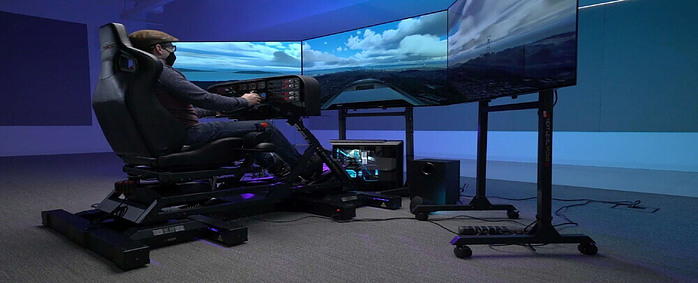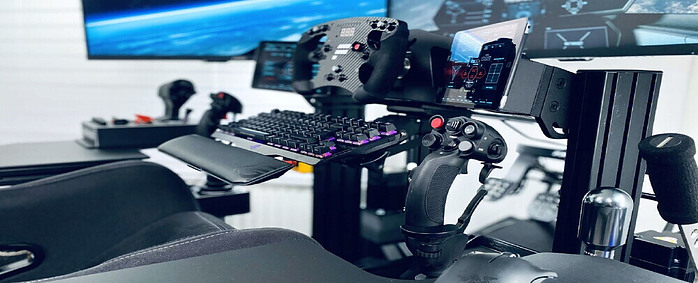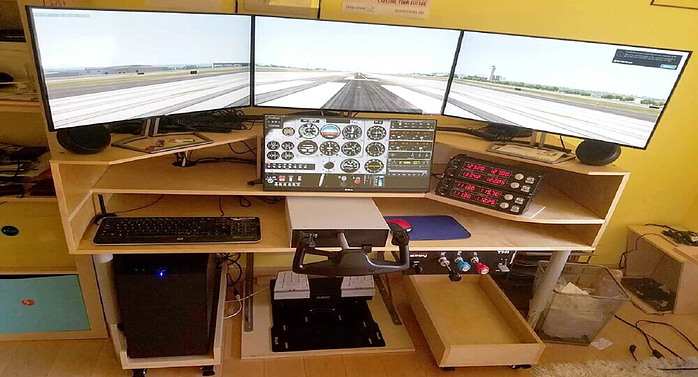Flight Simulator Desk Setup Guide – Create Your Own Home Simulator in 2024:

Creating your home simulator is like building your own world of flight, and the best part is, you get to decide how wild or chill it’s going to be! Picture this: you kick things off with just a laptop and a joystick, keeping it easy-breezy. But hey, as you get the hang of it and catch the flight sim bug, you might spice things up with extra screens or some fancy flight controls.
Now, when it comes to home sim setups, it’s like a spectrum, right? On one end, you’ve got the subtle, almost incognito setups, and on the other, people turning entire rooms into Airbus cockpits! The big questions to ask yourself are: How deep do you want to dive into this, what’s your budget dance, and what’s the endgame you’re shooting for?
At the bare minimum, you’re cruising with a laptop and a simple stick controller. But if you’re aiming for the stars, think gaming PC, a bunch of screens, a yoke flight control (with a throttle quadrant for that extra oomph), rudder pedals, and a sweet setup to fit it all. It’s your flight, captain – how far do you want to take it?
It’s Time to Make Your Home Simulator:

Alright, buckle up for the lowdown on crafting your very own flight training and study haven!
Imagine you’re on a mission to nail that private pilot certificate. Now, let’s get real – you don’t need a decked-out 747-8 cockpit for that journey. We’re talking about mastering the basics, the ABCs of flying.
So, what’s the perfect setup for your study haven? Think middle-of-the-road flight simulator vibes.
You’ve got your essentials: a trusty computer and a slick monitor, plus the controls – yoke, throttle, and rudder – are the real MVPs. And hey, if you’re feeling a bit extra, throw in some cool extras.
Just remember, while your home flight simulator is like a sidekick during your training grind, it’s not the substitute for actual flight time. It’s the wind beneath your wings, not the whole shebang!
The Basic Setup:

Alright, let’s dive into the fun part of crafting your setup – think of it like tailoring it specifically for your favorite flying machine! Here’s the cool breakdown of the four key hardware amigos for your simulator shindig:
Computer and Monitors – Your trusty sidekick in this adventure. The brains and screens that’ll bring your virtual skies to life!
Flight Controllers – The real MVPs – your yoke, joystick, throttle – the hands-on magic that turns you into the captain of your virtual domain.
Extra Peripherals – Time to jazz things up! Switch panels, tablets, or any extra gadgets that make your setup uniquely yours. Like the secret sauce for your simulation recipe!
A Place to Set It All Up – Last but not least, your stage! Whether it’s a desk, a special stand, or your own cockpit-inspired haven – it’s the spot where the magic unfolds.
So, get ready to bring your flying dreams to life with this awesome quartet of simulator essentials!
Computer and Monitors for Flight Simulators:

Now, let’s delve into the beating heart of your setup – the computer and monitors. Your PC is the powerhouse propelling your virtual journey, and the monitors are the windows through which you’ll witness breathtaking landscapes. Opt for a computer with specifications that match the demands of your chosen flight simulator. While you don’t need a NASA-level supercomputer, a robust gaming rig will ensure a smooth and immersive experience.
Monitors come in all shapes and sizes, offering a spectrum of choices to cater to your space and preferences. Consider a multi-monitor setup for a panoramic view, or go for a single high-quality screen for an intense and focused experience. The goal is not just quantity but the quality of visuals that will make your heart race as you ascend through the virtual clouds.
Flight Controls – Yokes, Sticks, and Rudder Pedals:
Now, let’s get hands-on – literally! The flight controls are your direct link to the virtual aircraft. Whether you’re gracefully gliding through serene skies or navigating turbulent weather, the right set of controls can elevate your experience to new heights.
A yoke provides a realistic feel, perfect for those aspiring to command large aircraft. If you’re inclined towards a more nimble experience, a joystick is your go-to, offering responsiveness and agility. Don’t overlook the importance of rudder pedals – they add finesse to your maneuvers, letting you feel the nuances of flight.
Remember, your choice of controls depends on the type of flying adventures you envision, from leisurely Cessna flights to acrobatic feats in an F-16.
Switches and Extras:
You’ve nailed down the essentials, but why stop there? Let’s inject some personality with switches and extras. These details transform a good simulator into an extraordinary one.
Imagine having a physical switch panel at your fingertips, granting you control over various aircraft functions without navigating virtual menus. It’s like upgrading from a sedan to a sports car – those extra buttons add a touch of sophistication to your setup.
Consider integrating tablets into your cockpit. They can serve as secondary screens for charts, maps, or even function as a virtual checklist. Creating a personalized and efficient cockpit is all about these little details that cater to your unique flying style.
Here’s a pro tip – ambient lighting! Elevate your simulator experience with LED strips or smart bulbs that set the mood. Dim the lights for a night flight or immerse your cockpit in warm hues during a sunset approach. It’s these subtle touches that transform your flight simulation from good to extraordinary.
Conclusion:
And there you have it – the comprehensive guide to setting up your personal Flight Simulator at home. From selecting the right computer to fine-tuning your controls and adding those extra touches, you’re now equipped to venture into the boundless world of virtual aviation.
This is your flight, your adventure. Start small, dream big, and let your home simulator evolve with your growing passion for aviation. So, what are you waiting for? Strap in, throttle up, and soar into the boundless world of virtual aviation!
Happy flying and see you soon in the next article!

Hi, I’m not surprised that you can customize your own home simulator. It’s amazing how good the graphics have gotten today for virtual reality and that kind of thing. Except that it’s even going to get way way better in the coming years. Right now VR is still in its infancy. But same thing for flight simulator it is going to improve a lot as well. And the fact that you can customize it right now is proof of that. Have a good one.
Thanks for the feedback, as long as you have the right tools you can customize it to any level you like.
This Is such an awesome topic I would not mind having this flight simulator and pretend I am the worlds best pilot.
I like your blog because you explain everything 100% in detail.
I for one that do not understand technology that much, by reading your blog understand it much better now.
Thanks for shearing this and keep up the good work.
Thanks for the feedback.
Your flight simulator desk setup guide is fantastic! I’ve been considering creating my own home simulator, and your detailed breakdown of essential components and setup recommendations is incredibly helpful. Have you personally built a flight simulator using these tips? I’d love to hear about your experience and any specific challenges you encountered along the way.
Additionally, your advice on ergonomic considerations is crucial. Comfort during long sessions is key, and your emphasis on adjustable desks and proper seating aligns perfectly with my own experience. How do you suggest balancing functionality and budget when setting up a home simulator? It’s a fine line, and your insights could be invaluable for those trying to achieve a balance. Thank you for sharing such a comprehensive and practical guide!
Thanks for the feedback and visiting my website. I have not built Flight Simulator using desk. You need some budget to set up flight simulator cockpit at home. What do you mean by balance functionality?
This post was really helpful and easy to follow. Reading your in-depth analyses and well-explained points is a delight. I found the samples you provided to be really useful. Your expertise is much appreciated.
This post is very well-researched, and I appreciate you sharing it. What you said was really helpful and pertinent, and I appreciate it. You made the concepts really clear and easy to understand. When you have time, I would love to read more of your articles.